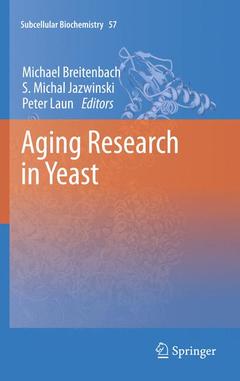Description
Aging Research in Yeast, 2012
Subcellular Biochemistry Series, Vol. 57
Coordinators: Breitenbach Michael, Jazwinski S. Michal, Laun Peter
Language: English
Subjects for Aging Research in Yeast:
Keywords
Aging; Cell Death; Cell Quality Control; Sacchromyces cerevisiae; Yeast; Apoptosis
Publication date: 01-2014
368 p. · 15.5x23.5 cm · Paperback
Publication date: 11-2011
368 p. · 15.5x23.5 cm · Hardback
Description
/li>Contents
/li>Comment
/li>
1. Preface and Introduction to Aging research in Yeast.- 2.Oxidative stresses and ageing.- 3.The role of Mitochondria in the aging processes of yeast.- 4.The Retrograde Response and Other Pathways of Interorganelle Communication in Yeast Replicative Aging.- 5. Chronological Aging in Saccharomyces cerevisiae.- 6. Still waters run deep: Aging and the survival of quiescent and non-quiescent cells in yeast stationary-phase cultures.- 7. Maximising the yeast chronological lifespan.- 8.Amino Acid Homeostasis and Chronological Longevity in Saccharomyces cerevisiae.- 9. DNA damage and DNA replication stress in yeast models of aging.- 10.Yeast aging and apoptosis.-11. Cellular homeostasis in fungi: Impact on the aging process.- 12.Genome-wide analysis of yeast aging.- 13. Genetic Approaches to Aging in Budding and Fission Yeasts: New Connections and New Opportunities.- 14. Evolution of asymmetric damage segregation: a modelling approach.-15. Cellular ageing and the actin cytoskeleton.
These books may interest you

The Molecular Genetics of Aging 52.74 €



